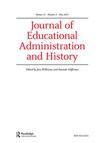Educational Leadership and Policy: Precarity and Precariousness
IF 1.6
Q2 EDUCATION & EDUCATIONAL RESEARCH
Journal of Educational Administration and History
Pub Date : 2021-11-24
DOI:10.1080/00220620.2021.2006880
引用次数: 2
Abstract
This special issue brings a range of perspectives to explore questions of the connections between notions of precarity and education. Authors in this issue explore the myriad ways precarity affects educational leaders and how precarity and education policy are intertwined broadly. The issue was first conceptualised in 2019 in response to ongoing concerns about precarious employment in education casualised academia in higher education, increasing reports of short-term teaching contracts, and performance-based contracts for school leaders. Education systems and sectors around the globe are functioning in increasingly casualised workforce environments, which has implications for leadership in schools and in higher education institutions. Precarity also holds serious implications for policymakers and for the leaders and educators who have to enact those policies. We know, for example, that the work of school improvement takes time. Developing a highly-skilled and confident teaching workforce requires a long-term investment and commitment. Schools in vulnerable communities face higher rates of turnover and difficulty in staffing. Tackling the big issues in education – inequity, opportunity gaps, democracy and cohesion – also takes time. How are precarious leaders, or leaders in precarious organisations, able to make long-term plans to address these challenges? The rise of the gig economy also holds significant implications for young people today, and how education is preparing them for an uncertain future. This is not new by any means and Lee and Kofman (2012, 389) describe precarious employment as ‘not just the outcome of an inexorable, almost mechanical, pendulum swing from “security” to “flexibility” but a core part of the state’s strategy of development’. While precarious employment and working conditions are not a new development, Millar (2017) suggests that the question may be asked “for whom is precarity new?” Alberti et al. (2018, 3) note that “precarity is [the] consequence of an unequal distribution of protection within society, which leaves some groups more exposed to precariousness than others”. However, they also caution against underestimating the “scope of change in the world of work and employment: it is not only ‘the precariat’ that has to deal with increasing precarity”. Indeed, one of the papers in this special issue (Stacey et al. 2021) deals with the working conditions of a profession that was once considered stable and secure. These教育领导与政策:不稳定性与不稳定性
本期特刊带来了一系列视角,探讨不稳定概念与教育之间的联系问题。本期作者探讨了不稳定性影响教育领导者的无数方式,以及不稳定性和教育政策如何广泛地交织在一起。这一问题最初是在2019年提出的,以回应人们对教育就业不稳定、高等教育学术界非正式化、关于短期教学合同的报道越来越多以及学校领导基于绩效的合同的持续担忧。世界各地的教育系统和部门都在日益松散的劳动力环境中运作,这对学校和高等教育机构的领导力产生了影响。不稳定性对政策制定者以及必须制定这些政策的领导人和教育工作者也有严重的影响。例如,我们知道改善学校的工作需要时间。培养一支高技能和自信的教师队伍需要长期的投资和承诺。弱势社区的学校面临更高的人员流动率和人员配备困难。解决教育中的重大问题——不平等、机会差距、民主和凝聚力——也需要时间。不稳定的领导者或不稳定组织中的领导者如何制定长期计划来应对这些挑战?零工经济的兴起也对今天的年轻人产生了重大影响,以及教育如何让他们为不确定的未来做好准备。无论如何,这并不新鲜,Lee和Kofman(2012, 389)将不稳定就业描述为“从‘安全’到‘灵活性’的不可阻挡的、几乎机械的钟摆摆动的结果,而且是国家发展战略的核心部分”。虽然不稳定的就业和工作条件并不是一个新的发展,但米勒(2017)建议,这个问题可能会被问到“不稳定对谁来说是新的?”Alberti等人(2018,3)指出,“不稳定性是社会内部保护分配不平等的结果,这使得一些群体比其他群体更容易受到不稳定性的影响”。然而,他们也警告说,不要低估“工作和就业领域的变化范围:不仅仅是‘不稳定阶层’必须应对日益增加的不稳定”。事实上,本期特刊中的一篇论文(Stacey et al. 2021)讨论了一个曾经被认为稳定和安全的职业的工作条件。这些
本文章由计算机程序翻译,如有差异,请以英文原文为准。
求助全文
约1分钟内获得全文
求助全文
来源期刊

Journal of Educational Administration and History
EDUCATION & EDUCATIONAL RESEARCH-
CiteScore
3.80
自引率
5.60%
发文量
25
 求助内容:
求助内容: 应助结果提醒方式:
应助结果提醒方式:


